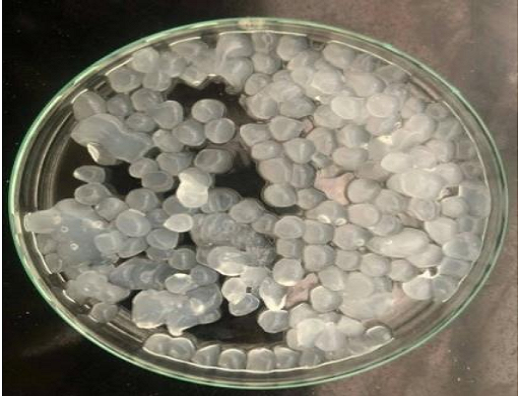Lead Ion Removal in Water Using Low Methoxy Pectin-Guar Gum Beads Hybrid Adsorbent
Abstract
A high level of lead in the sediment will cause contamination of aquatic biota. Lead pollutants in water may be treated by an easy and common adsorption process. A combination of both environmentally friendly and renewable materials, low methoxy pectin (LMP), and guar gum as adsorbents can reduce the need of activated carbon which requires high temperatures in its synthesis process. LMP was prepared from high methoxy pectin using a demethylation process under alkaline conditions. LMP and guar gum are diluted in 1 M calcium chloride as a crosslinking agent. The degree of esterification was carried out to determine the demethylation process. Adsorption of lead was carried out with a lead concentration of 165 ppm in acidic conditions for 24 hours. Lead concentration was measured using AAS. Results show that the optimal pH for demethylation was 12. The ratio of 1:2 pectin-guar gum produces the strong beads related to more O-H bonds in guar gum that can be developed. pectin-guar gum beads can adsorb 63% of lead at pH 6 due to the development of hydro-complex metal ions under more basic conditions.
Downloads

Copyright (c) 2022 Nadya Nursidah Pratiwi Subroto, Fadhil Muhammad Tarmidzi, Ina Wati, Velia Mulya Armans

This work is licensed under a Creative Commons Attribution-NonCommercial-NoDerivatives 4.0 International License.
Authors who publish with this journal agree to the following terms:
- Copyright on any article is retained by the author(s).
- The author grants the journal, the right of first publication with the work simultaneously licensed under a Creative Commons Attribution License that allows others to share the work with an acknowledgment of the work’s authorship and initial publication in this journal.
- Authors are able to enter into separate, additional contractual arrangements for the non-exclusive distribution of the journal’s published version of the work (e.g., post it to an institutional repository or publish it in a book), with an acknowledgment of its initial publication in this journal.
- Authors are permitted and encouraged to post their work online (e.g., in institutional repositories or on their website) prior to and during the submission process, as it can lead to productive exchanges, as well as earlier and greater citation of published work.
- The article and any associated published material is distributed under the Creative Commons Attribution-NonCommercial-NoDerivatives 4.0 International License.





_copy1.png)










